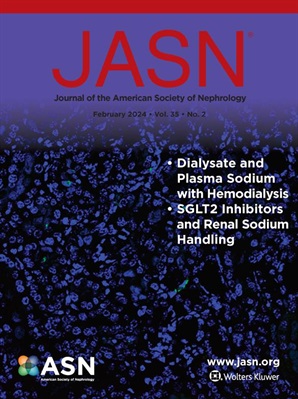高磷酸盐和低蛋白介导CKD小鼠动脉和皮肤血管钙化。
IF 9.4
1区 医学
Q1 UROLOGY & NEPHROLOGY
引用次数: 0
摘要
背景:内侧动脉钙化和皮肤小动脉钙化在慢性肾脏疾病(CKD)患者中很普遍,并且与发病率和死亡率增加密切相关。然而,目前的实验性CKD模型往往不能完全复制内侧动脉钙化和皮动脉钙化的模式,限制了我们阐明其潜在分子途径的能力。建立一个可靠的ckd相关钙化实验模型,并利用它来确定治疗靶点,对于推进这些血管并发症的治疗策略至关重要。在这项研究中,我们采用了一种新的策略,即结合高磷酸盐和低蛋白饮食来促进CKD小鼠内侧动脉和皮肤血管钙化。方法smice行5/6肾切除术,饲喂不同的日粮。采用显微ct扫描、茜素红染色、Von Kossa染色和钙含量测定评估血管钙化情况。肾脏损害和纤维化也被评估。RNA测序(RNA- seq)分析鉴定关键分子通路。我们使用药理学抑制剂SB203580来确定p38 MAPK信号在体内的意义。结果高磷酸盐低蛋白(HPi-Lp)饮食显著诱导5/6肾切除小鼠内侧动脉和皮血管钙化,加重肾功能障碍和纤维化。p38 MAPK信号被高度激活。p38 MAPK信号的药理抑制可显著减少内侧动脉和皮肤血管钙化以及相关的肾纤维化。结论5/6肾切除CKD小鼠模型联合高磷酸盐低蛋白饮食可有效复制内侧动脉和皮动脉钙化。本文章由计算机程序翻译,如有差异,请以英文原文为准。
High Phosphate and Low Protein Mediate Arterial and Cutaneous Vascular Calcification in CKD Mice.
BACKGROUND
Medial artery calcification and cutaneous arteriolar calcification are prevalent in patients with chronic kidney disease (CKD) and are strongly associated with increased morbidity and mortality. Current experimental CKD models, however, often fail to fully replicate the patterns of medial artery calcification and cutaneous arteriolar calcification, limiting our ability to elucidate their underlying molecular pathways. Developing a reliable experimental model for CKD-associated calcification and using it to identify therapeutic targets is essential for advancing treatment strategies for these vascular complications. In this study, we used a novel strategy that incorporated a high phosphate and low protein diet to promote medial artery and cutaneous vascular calcification in CKD mice.
METHODS
Mice underwent 5/6 nephrectomy and were then fed various diets. Vascular calcification was assessed using micro-CT scans, Alizarin Red staining, Von Kossa staining, and calcium assays. Kidney impairment and fibrosis were also evaluated. RNA sequencing (RNA-Seq) analysis was performed to identify key molecular pathways. The pharmacological inhibitor SB203580 was used to determine the significance of p38 MAPK signaling in vivo.
RESULTS
The high phosphate and low protein (HPi-Lp) diet markedly induced both medial artery and cutaneous vascular calcification in 5/6 nephrectomy mice while exacerbating kidney dysfunction and fibrosis. The p38 MAPK signaling was specifically highly activated. Pharmacological inhibition of p38 MAPK signaling significantly reduced medial artery and cutaneous vascular calcification as well as associated kidney fibrosis.
CONCLUSIONS
The 5/6 nephrectomy CKD mouse model combined with a high phosphate and low protein diet effectively replicated medial artery and cutaneous arteriolar calcification.
求助全文
通过发布文献求助,成功后即可免费获取论文全文。
去求助
来源期刊
CiteScore
22.40
自引率
2.90%
发文量
492
审稿时长
3-8 weeks
期刊介绍:
The Journal of the American Society of Nephrology (JASN) stands as the preeminent kidney journal globally, offering an exceptional synthesis of cutting-edge basic research, clinical epidemiology, meta-analysis, and relevant editorial content. Representing a comprehensive resource, JASN encompasses clinical research, editorials distilling key findings, perspectives, and timely reviews.
Editorials are skillfully crafted to elucidate the essential insights of the parent article, while JASN actively encourages the submission of Letters to the Editor discussing recently published articles. The reviews featured in JASN are consistently erudite and comprehensive, providing thorough coverage of respective fields. Since its inception in July 1990, JASN has been a monthly publication.
JASN publishes original research reports and editorial content across a spectrum of basic and clinical science relevant to the broad discipline of nephrology. Topics covered include renal cell biology, developmental biology of the kidney, genetics of kidney disease, cell and transport physiology, hemodynamics and vascular regulation, mechanisms of blood pressure regulation, renal immunology, kidney pathology, pathophysiology of kidney diseases, nephrolithiasis, clinical nephrology (including dialysis and transplantation), and hypertension. Furthermore, articles addressing healthcare policy and care delivery issues relevant to nephrology are warmly welcomed.

 求助内容:
求助内容: 应助结果提醒方式:
应助结果提醒方式:


